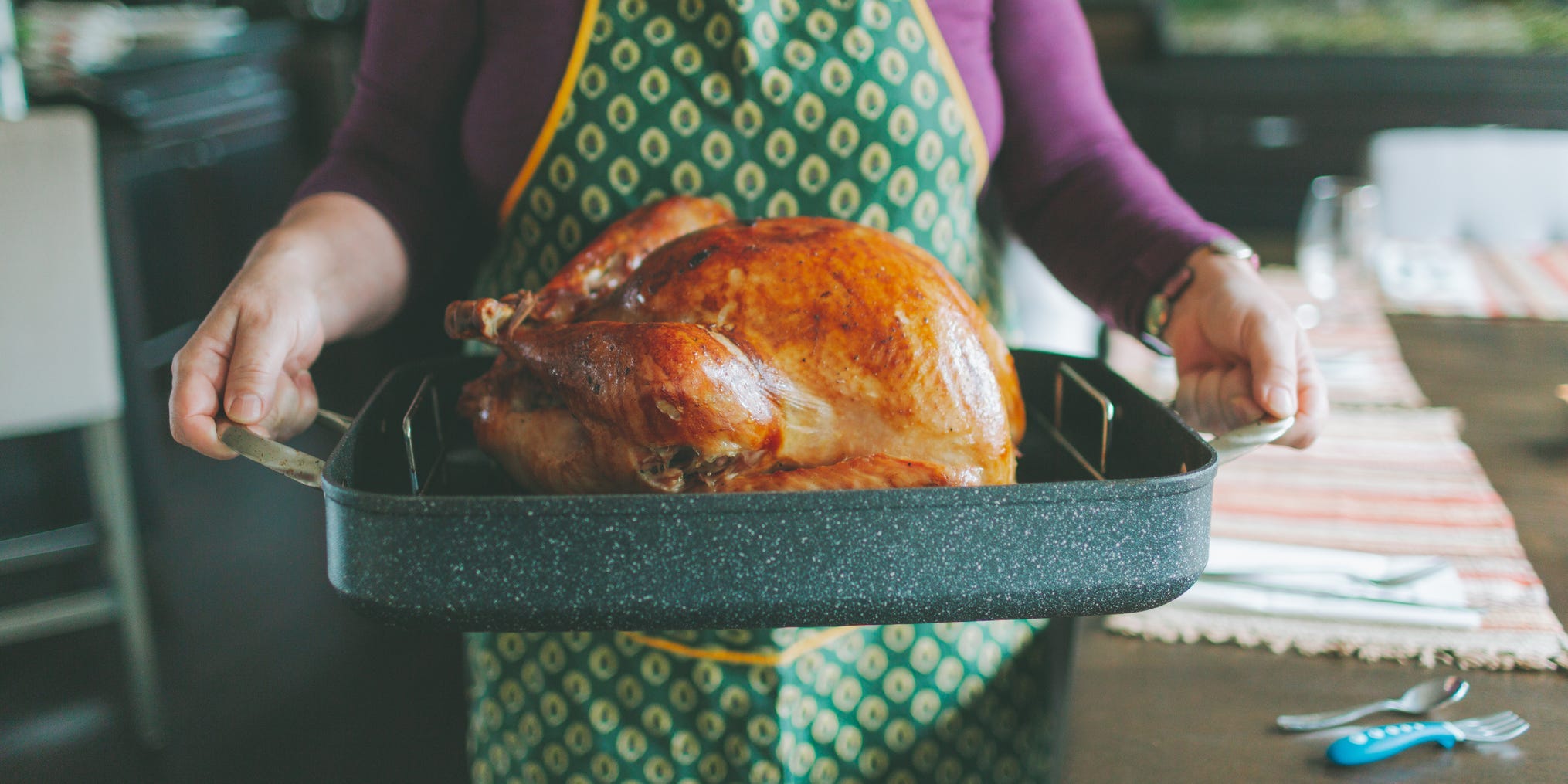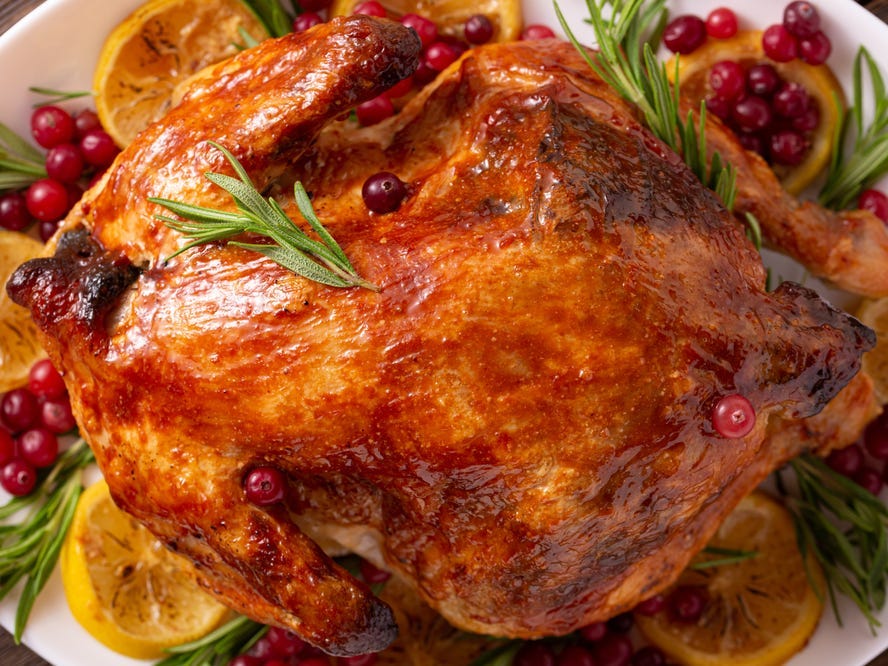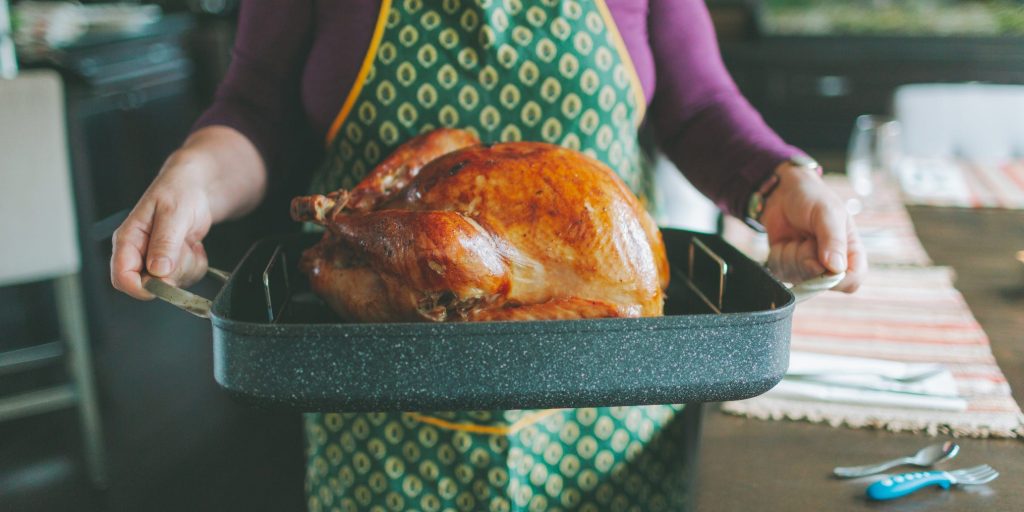
Crystal Sing / EyeEm/Getty Images
- Brining a turkey in advance is one of the best ways to season the meat and keep it juicy and tender.
- A wet brine involves submerging the raw turkey in a mixture of salt and water with optional aromatics.
- Dry brining is a popular alternative because it requires less effort and space.
- Visit Insider's Home & Kitchen Reference library for more stories.
One way to guarantee a flavorful turkey? Brine it.
When it comes to brining a turkey, you've got two options: A traditional wet brine of soaking the bird in a salt solution. Or a dry brine (also called "pre-salting"), which involves applying salt to the turkey directly.
In either case, salt is the most important component. As the bird marinates, the salt permeates the meat, adding flavor and moisture.
"Brining your turkey helps to ensure a juicy and delicious – not dry – outcome is achieved once roasted," says Heidi Diestel, fourth-generation turkey farmer with Diestel Family Ranch. "It adds some extra insurance to the whole roasting process."
In addition to yielding a juicy bird and adding flavor, brine has the added bonus of acting as a tenderizer. "The salt in your brine also helps break down some of the turkey's proteins, which leads to a tender roasted bird," says Diestel.
Wet or dry brine: Which is better?
The choice to wet brine or dry brine a turkey depends on your equipment, how much time and space you have, and how much effort you want to put into the whole process.
On a practical level, it's difficult to submerge an entire turkey overnight in the fridge. In addition to fridge space, you need a container big enough to hold the turkey submerged in water. The wet brining process takes anywhere from eight to 18 hours.
Dry brining is a popular alternative to wet brining because it cuts out the water so there's less to deal with. The process is literally just coating the raw bird in salt, plus herbs. However, dry brining typically takes more time than wet brining, up to three days.
Alternative method: Dry brining
If wet brining sounds like a lot of work, you'll want to learn the dry brine technique, which ditches the water and applies the salt directly to the bird.
While wet brining makes for a reliably juicy turkey, Diestel notes that it requires considerable fridge space and can be messy, thanks to all of the water-based brine. "Dry brining offers an easier alternative that often yields a crispier skin, but it's a longer process than wet brining," says Diestel.
To dry brine, make sure the turkey is cleaned out. First, pat the turkey dry with paper towels. Next, rub the turkey with kosher salt (1 to 2 teaspoons per pound of meat), making sure you get into the cavity of the turkey, as well as under the skin. Like with wet brining, you can also rub any additional herbs or spices.
Once salted, place the turkey in a large bowl or rimmed baking sheet. Store it uncovered in the fridge, at least one hour per pound. "You can leave it in the fridge for up to three days," says Diestel.
When it's done brining, allow the dry-brined turkey to come to room temperature - there is no need to rinse it. Once ready, cook the turkey however you like.
Notes and tips

G.MARTYSHEVA/Shutterstock
- Start with a great turkey: "My biggest tip is to start with a high-quality turkey," says Diestel. If previously frozen, make sure it is completely thawed before you start brining.
- The type of salt you use is important. The size of granules matters. Kosher salt has wider, coarser crystals than table salt, which means you need to use twice as much. Be sure to account for that in your measurements.
- Time it right. While an overnight brine leads to a juicy bird, brining for too long yields diminishing returns. "Over 18 hours in a wet brine can lead to a mushy texture," says Diestel. The same goes for dry brining - don't exceed three days in the fridge.
- Dry completely for crispy skin. Diestel recommends patting the turkey dry with paper towels and leaving it uncovered in the fridge for a few hours before roasting for the crispest results. A coating of oil or butter won't hurt, either, adding even more crispiness and a deep golden color.
- Ditch the whole bird if you're short on space. If your fridge (or oven) simply can't handle a whole, large bird, Diestel recommends trying a petite turkey or roasting a turkey breast instead. They can be brined using the same methods as a full-sized bird.
Insider's takeaway
Brining is an easy way to infuse a turkey with flavor and make sure that your bird will emerge from the oven tender and juicy. If you have space in your fridge, try an overnight wet brine and add your choice of aromatics. Dry brining, on the other hand, is an easy alternative that takes up less space and doesn't involve any liquids. The method you choose, whether it's wet or dry brine, will ultimately depend on personal tastes and how much time you have.
